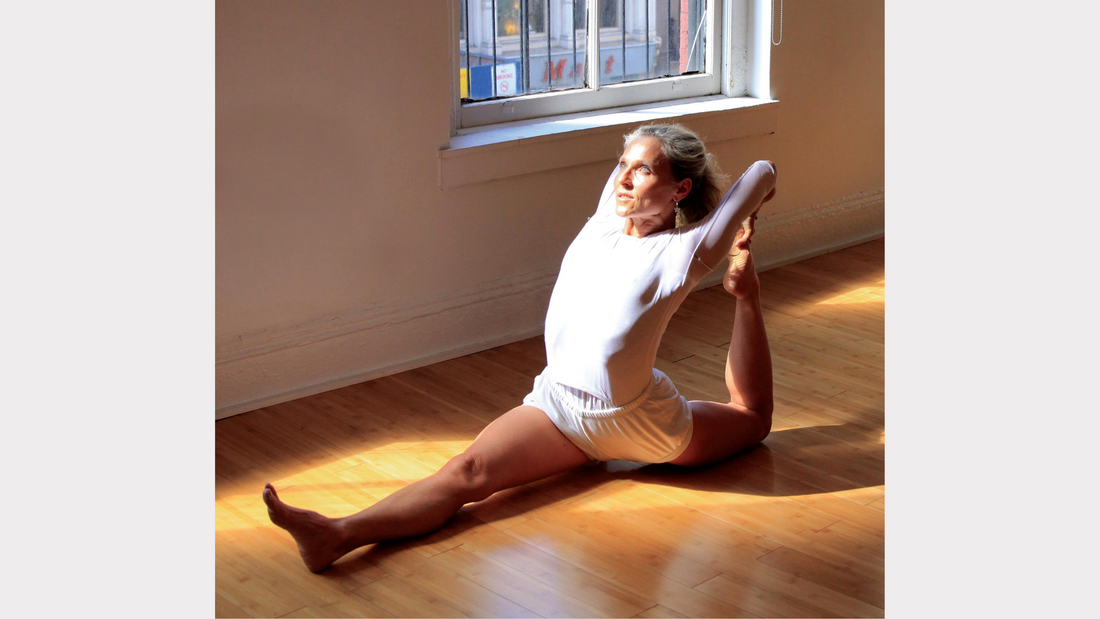
Carrie Owerko: Interview On Play, Possibility, and the Art of Yoga
I am so excited to be featuring Carrie Owerko here on the Malaika Padma blog.
Carrie has been called a New York legend, known for her passionate, energetic teaching and her signature joy. I first discovered her years ago through her Playful Practice with a Chair series, where she thoughtfully structured each session around one of the five classical elements: earth, water, fire, air, and space.
Her attention to detail was nothing short of inspiring, not just in her creative sequencing, but in the way she visually expressed the elements. For each practice, she chose Pune shorts that mirrored the qualities of the element: grounding earth tones for stability, cool blues for the adaptability of water, bold reds or oranges for fire’s transformation, light hues for airy expansiveness, and ethereal designs for the subtlety of space.
It was clear that Carrie wasn’t just teaching postures, she was inviting us to experience each element fully, blending movement, breath, and playful exploration with each theme. Her creativity guided me into poses I’d once thought were beyond my reach. I still remember the joy of balancing in Astavakrasana and Mayurasana after following her variations, without her ever seeing me on the other side of the screen!
Here was a strong, intelligent, and endlessly creative teacher helping us see our own possibilities. I taught her variations in my classes and never stopped talking about this inspiring teacher I was lucky to discover online.
Today, Carrie continues to surprise and delight, bringing her theatre and dance background into her teaching and encouraging us to experiment, play, and find joy in our practice. I’ve wanted to ask her for a long time what inspired her to branch out from her traditional Iyengar teaching. So, I reached out, and as always, she joyfully shared her answers with us.
Q: Could you tell us about your background, where you’re from and how you first found your way into yoga and movement?
Carrie:
I grew up in a small town in rural New Mexico. I fell in love with musical theatre and dance at an early age after a traveling theatre troupe came through our town. I set my sights on leaving and finding my way to the big city someday.
After studying theatre and dance in college, I joined a traveling troupe and eventually made my way to New York City, where I trained in a conservatory and worked professionally for about 10 years.
During that time, I became interested in studying movement more deeply and completed my studies at the Laban Bartenieff Institute of Movement Studies. I began practicing yoga while I was still performing, and it’s been part of my life ever since.
Q: Your background in theatre and dance is quite unique among yoga teachers. How has that shaped your perspective on yoga?
Carrie:
The theatre is a magical place. Once you’ve let your imagination go in that world, you’re never the same, you see possibility everywhere and recognize the power of play.
“Play is a low-stakes way to explore options—it’s the best way to keep learning new things.”
You also realize that it’s all made up! Humans created yoga, theatre, philosophy… so why are we putting ourselves or anyone else in a box? Why do we think there’s a “right” way?
Play reminds us to do things for their own sake. And it’s the best way to learn and to keep learning new things.
Q: You’ve been deeply rooted in the Iyengar tradition. What led you to explore other movement modalities and step away from being a “strictly Iyengar” teacher?
Carrie:
As I studied movement science in greater depth and opened myself up to new teachers and disciplines, I saw possibilities that the method at that time didn’t allow.
I wanted to keep learning and growing as a person, which meant saying yes to inquiries outside of Iyengar Yoga. Being open-minded isn’t always comfortable—your biases get challenged, and you face uncertainty.
Many people stay in systems that don’t truly make them happy because it’s part of their identity. But asking “What if?” opens the door to new ways of moving, thinking, and being.
Q: In Tree of Yoga, B.K.S. Iyengar describes yoga as an art. Do you feel your current approach is still aligned with that vision?
Carrie:
B.K.S. Iyengar had a specific aesthetic, which could appear hard or rigid to someone not versed in the method. His ideas about “correct” alignment were based on his preferences and, some would argue, outdated ideas of posture.
“If you feel your yoga is art, that is a beautiful thing. What others think does not matter.”
For me, yoga can absolutely be an art—but what counts as art is subjective. At the end of the day, we’re all better off doing what we love and what brings us joy. That joy makes us kinder to ourselves and others.
Q: Following up on this, how do you balance alignment with individual anatomy and freedom of movement?
I think the salient points are that there isn't one universal correct alignment for a yoga pose or any movement for that matter, and pain is multifactorial and poorly correlated with posture in the scientific literature. Sometimes the Iyengar preferred alignment might not suit the person for a variety of reasons. There is a lot of variability in individual anatomy so implying that there is one 'correct' way or ideal to do a pose or movement is problematic.
There is often an over emphasis on how things look in Iyengar Yoga, as opposed to how they feel to the person doing the movement or pose. How often are students encouraged to explore movement options (How does it feel if you turn your foot in here or turn it out?) vs trying to recreate the version given in Light on Yoga. The mover has agency and bodily autonomy.
But that autonomy is (or was) often lost in Iyengar Yoga where students are given adjustments (sometimes rough or injurious ones) forcing an "alignment" that might not suit their capacity or anatomy and often doing so against their will (this happened to me). Every movement tends to be micro-managed by the teacher. The over-instruction or micromanagement can disrupt the motor learning process for the learner.
There are wonderful things in Iyengar yoga, but these are some of the things that have been seen as problematic.
Q: You’ve practiced in our Malaika Padma Pune shorts for years. How do you see clothing as part of self-expression in practice?
Carrie:
At busy times in my life, I don’t think much about what I wear—but when I do, I think clothing can be part of how we communicate. Most importantly, I like to feel comfortable in my skin and in my clothes.
Q: Let’s finish with some quick-fire questions…
If you could create a yoga pose inspired by any animal, what would it be?
I’d think of something more like a movement—the path a bird makes in the air or the arc of a dolphin playing in the water.
Most unexpected place you’ve practiced?
The caves of Petra.
Music that always gets you moving?
I love all kinds! Percussive, rhythmical music and jazz are favorites.
Favorite unexpected prop?
Socks, blankets, or sliders—anything that lets me slide and glide.
Advice to your younger self about yoga?
“It’s not about the pose, the alignment, or the ‘right’ way. It’s about the inquiry.”

Carrie’s approach is a reminder that yoga is alive, evolving, and deeply personal. By making room for curiosity, joy, and play, she shows that our practice can be both rooted and free.
Carrie offers a rich variety of online courses, and I truly cannot recommend them enough. Her library spans everything from classic (yet game-changingly creative) Iyengar Yoga series to her more recent releases, where she blends intelligent sequencing, playful exploration, and elements of dance into deeply engaging movement practices.
Below, I’ve included two videos that showcase her unique teaching style—one highlighting her inventive approach to Iyengar foundations, and the other capturing her joyful fusion of yoga and dance-inspired movement.
Carrie Owerko's classic Iyengar yoga, Playful Practice w/ the chair: elements.
An Interview with Carrie showcasing her modern teaching (or playing ;) ) style that you should all check out!
The courses are available for purchase on the Playground section of Carrie's official website.
To learn more about Carrie’s work, visit her website, or follow her on social media: Instagram, Tiktok, Facebook

